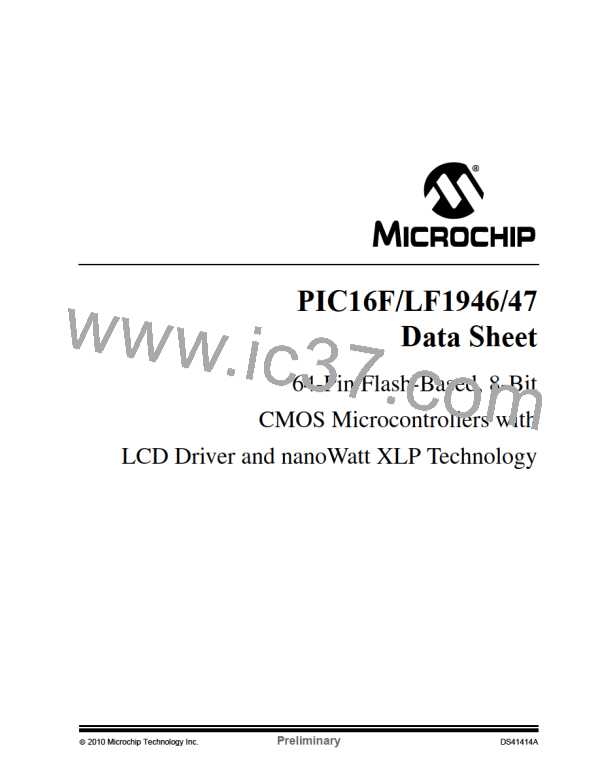PIC16F/LF1946/47
24.4.1.2
Clock Polarity
24.4 EUSART Synchronous Mode
A clock polarity option is provided for Microwire
compatibility. Clock polarity is selected with the CKTXP
bit of the BAUDxCON register. Setting the CKTXP bit
sets the clock Idle state as high. When the CKTXP bit
is set, the data changes on the falling edge of each
clock and is sampled on the rising edge of each clock.
Clearing the CKTXP bit sets the Idle state as low. When
the CKTXP bit is cleared, the data changes on the
rising edge of each clock and is sampled on the falling
edge of each clock.
Synchronous serial communications are typically used
in systems with a single master and one or more
slaves. The master device contains the necessary
circuitry for baud rate generation and supplies the clock
for all devices in the system. Slave devices can take
advantage of the master clock by eliminating the
internal clock generation circuitry.
There are two signal lines in Synchronous mode: a
bidirectional data line and a clock line. Slaves use the
external clock supplied by the master to shift the serial
data into and out of their respective receive and
transmit shift registers. Since the data line is
bidirectional, synchronous operation is half-duplex
only. Half-duplex refers to the fact that master and
slave devices can receive and transmit data but not
both simultaneously. The EUSART can operate as
either a master or slave device.
24.4.1.3
Synchronous Master Transmission
Data is transferred out of the device on the RXx/DTx
pin. The RXx/DTx and TXx/CKx pin output drivers are
automatically enabled when the EUSART is configured
for synchronous master transmit operation.
A transmission is initiated by writing a character to the
TXxREG register. If the TSR still contains all or part of
a previous character the new character data is held in
the TXxREG until the last bit of the previous character
has been transmitted. If this is the first character, or the
previous character has been completely flushed from
the TSR, the data in the TXxREG is immediately trans-
ferred to the TSR. The transmission of the character
commences immediately following the transfer of the
data to the TSR from the TXxREG.
Start and Stop bits are not used in synchronous
transmissions.
24.4.1
SYNCHRONOUS MASTER MODE
The following bits are used to configure the EUSART
for Synchronous Master operation:
• SYNC = 1
• CSRC = 1
Each data bit changes on the leading edge of the
master clock and remains valid until the subsequent
leading clock edge.
• SREN = 0(for transmit); SREN = 1(for receive)
• CREN = 0(for transmit); CREN = 1(for receive)
• SPEN = 1
Note:
The TSR register is not mapped in data
memory, so it is not available to the user.
Setting the SYNC bit of the TXxSTA register configures
the device for synchronous operation. Setting the CSRC
bit of the TXxSTA register configures the device as a
master. Clearing the SREN and CREN bits of the
RCxSTA register ensures that the device is in the
Transmit mode, otherwise the device will be configured
to receive. Setting the SPEN bit of the RCxSTA register
enables the EUSART. If the RXx/DTx or TXx/CKx pins
are shared with an analog peripheral the analog I/O
functions must be disabled by clearing the corresponding
ANSEL bits.
24.4.1.4
Data Polarity
The polarity of the transmit and receive data can be
controlled with the DTRXP bit of the BAUDxCON
register. The default state of this bit is ‘0’ which selects
high true transmit and receive data. Setting the DTRXP
bit to ‘1’ will invert the data resulting in low true transmit
and receive data.
The TRIS bits corresponding to the RXx/DTx and
TXx/CKx pins should be set.
24.4.1.1
Master Clock
Synchronous data transfers use a separate clock line,
which is synchronous with the data. A device configured
as a master transmits the clock on the TXx/CKx line. The
TXx/CKx pin output driver is automatically enabled when
the EUSART is configured for synchronous transmit or
receive operation. Serial data bits change on the leading
edge to ensure they are valid at the trailing edge of each
clock. One clock cycle is generated for each data bit.
Only as many clock cycles are generated as there are
data bits.
2010 Microchip Technology Inc.
Preliminary
DS41414A-page 309

 MICROCHIP [ MICROCHIP ]
MICROCHIP [ MICROCHIP ]